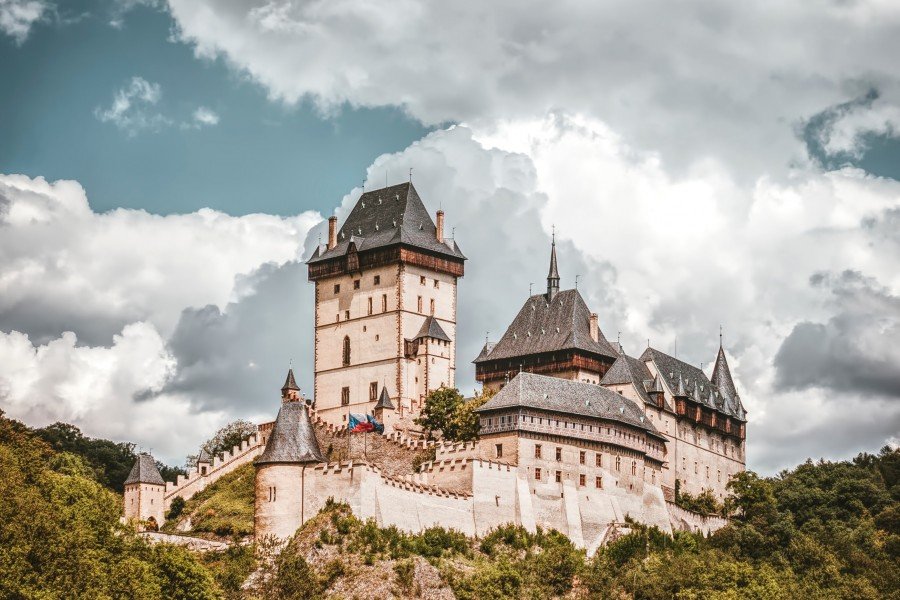Karlštejn Castle was founded in 1348 by the King of Bohemia and Holy Roman Emperor, Charles IV. This castle was meant to be a safe holding place for holy relics along with the Imperial Regalia and expensive crown jewels. Karlštejn is about 30 kilometers outside of the capital of Prague and is set upon hill-like terrain that is known for its internal layout of individual parts of the castle and their importance. It took two decades but officially was completed in 1365 by master craftsmen and builders from all across Europe, mainly Palestinians. Most prominently noted architect Mattias of Arras who is also cited for being architect of St. Vitus Cathedral in the Prague Castle Complex. After being built, Charles IV spent an entire year overseeing every detail of the interior which included all religious spaces within the castle.
The Castle showcases Gothic architecture with its towering walls, strategic fortifications, preserved spiraling staircases, spires, and intricate arches. Karlštejn is structured into three different levels; The Imperial Palace, the Marian Tower, and the Great Tower.
The Imperial Palace is the administrative center that handles all daily operations of the castle under Charles IV on the lower floors and connects to the royal residences on the upper floors. Located in this part of the castle, is one of the important and well-known rooms, the Knights’ Hall or Great Hall. This is where large gatherings and any official functions took place. With the location, it’s great to look out of the windows and view the stunning countryside.
The Marian Tower is known as the castle’s pillar of stability and spiritual center housing the Church of the Virgin Mary and the St. Catherine’s Chapel on its upper floors and the bottom houses the royal apartments for the emperor and his inner entourage of guests. If you were to make the trip to see this castle today, on guided tours this is primarily what you would walk through.
The Great Tower was constructed to be a tall pillar with thick walls and designed to have limited entry points thus making it able to stand strong and withstand any attacks while being an ample location of protection in times of siege. The Chapel of the Holy Cross is located on the top floor of the Great Tower and holds the Imperial Regalia and Holy Relics. Charles IV used this space as a place for private worship and somewhere significant for him to put the closest objects he found most important during his reign. The fortified nature and security of the Great Tower made it possible for us to learn and study the specifics of the history of the time regarding Charles IV.
Karlštejn for years housed the imperial crown, imperial orb, and the imperial sceptre along with the Bohemian crown jewels making this a stronghold location of cultural and religious importance. The chapel walls at the top of the Great Tower housed more than 2000 precious stones in its walls to not only be decorative but also ensure safety inside of these thick walls. Protecting all of these items was of the utmost importance because they represented symbols of royal authority and the legitimacy of the monarchy. This defensive stronghold never faced many battles but did remain on guard in times of threat and nearby conflict.
The Hussite Wars that took place 1419-1434 were a series of conflicts between the Hussites, otherwise known as followers of Jan Hus, and catholic supporters of the Holy Roman Empire. In 1422, Hussite forces led by Jan Žižka sieged the castle specifically to get their hands on the treasures that were stored at Karlštejn but they were never able to breach this interior due to the strategic design of the castle. During the Thirty Years’ War that took place 1618-1648 across central Europe and involved many powerful regimes, the castle, while never directly harmed, on more than one occasion there were threats to siege the fortress. In large part, this was due to the positioning of Karlštejn, while not in the direct path of battle, any trouble was never too far away so people at the castle were always on guard at this time.
The legacy of Karlštejn is of educational, historical, and cultural significance in central Europe and its gothic architecture remains iconic. Architect Josef Mocker led restorations of the castle beginning in the early 19th century to restore its overall medieval appearance. In the process of reaching this, preserving the gothic architecture and ornamental elements. The restoration of the castle allows us to see this crucial piece of Czech and European history.
Karlštejn Castle is a major tourist attraction in the Czech Republic that continues to draw in visitors from all over and with continued restoration kept up with and continued today, the castle is both informative and accessible for visitors. Tours are still held today so make sure the next time you’re nearby to take the day and explore the castle and picturesque town of Karlštejn.
Written by Jacqueline Nicole Denson
“Home -.” n.d. Karlštejn. Accessed June 6, 2024. https://www.hrad-karlstejn.cz/en.
“The Karlstejn Castle.” n.d. UNESCO World Heritage Centre. Accessed June 6, 2024. https://whc.unesco.org/en/tentativelists/1564/.
“Karlštejn Castle.” n.d. Central Bohemia. Accessed June 6, 2024. https://www.visitcentralbohemia.com/experience/karlstejn-castle/.
“Karlštejn Castle · #VisitCzechia.” n.d. #VisitCzechia. Accessed June 6, 2024. https://www.visitczechia.com/en-us/things-to-do/places/landmarks/castles-and-ruins/c-karlstejn-castle.
Moser, Melody. n.d. “Karlštejn Castle: A Hidden Gem in the Czech Republic.” Journeys Near and Far. Accessed June 6, 2024. https://www.journeysnearandfar.com/karlstejn-castle/.
National History Heritage. 2016. “The Castle of Karlstejn.” Mediaeval Histories. https://www.medieval.eu/the-castle-of-karlstejn/.
Polišensky, J. V. “Gallants to Bohemia.” The Slavonic and East European Review 25, no. 65 (1947): 391–404. http://www.jstor.org/stable/4203861.




